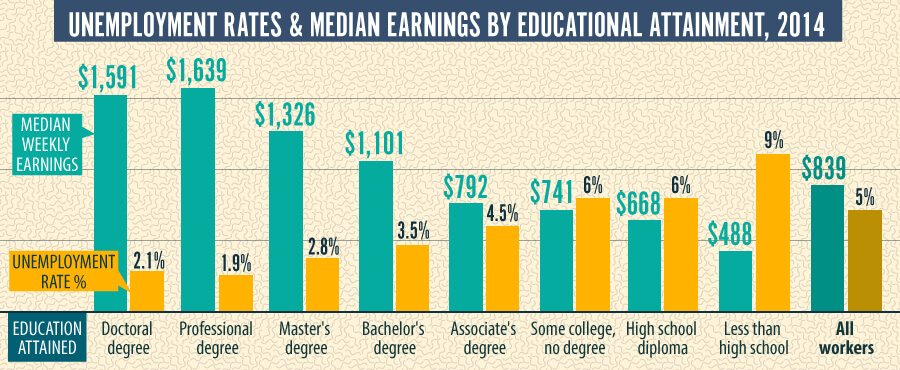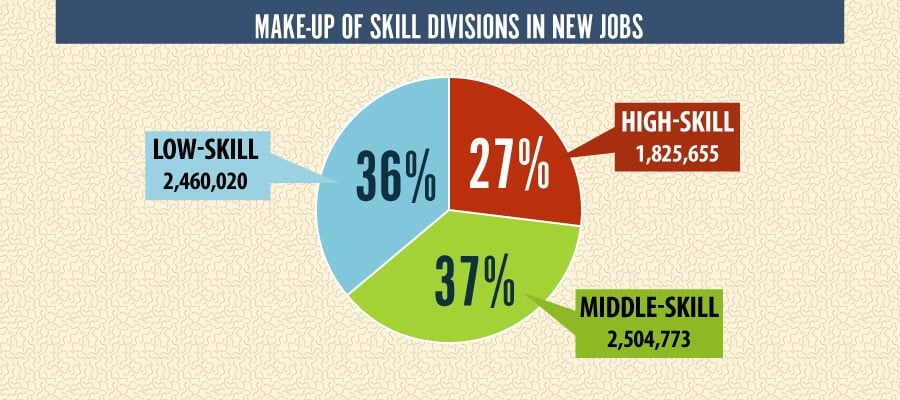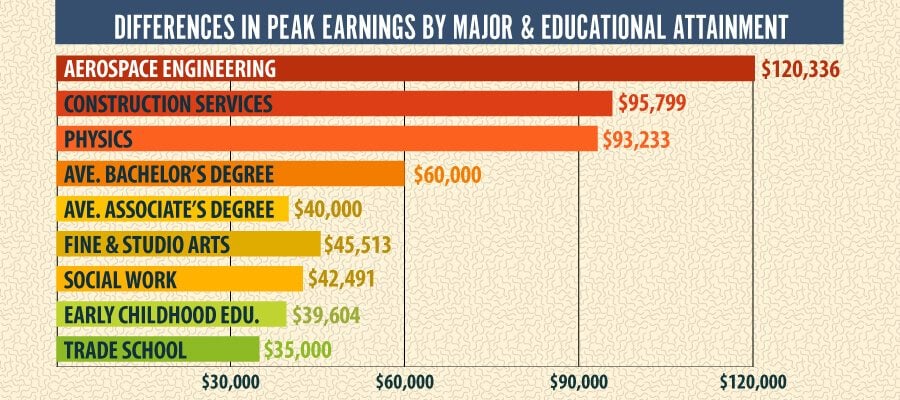University, Community College, or Trade School: Which Makes the Most Economic Sense?

Find your perfect value college
Deciding on postsecondary schooling for high school graduates is not the no-brainer decision it was just a few years ago. For many though, going to a four-year college is the be-all-end-all, and for one main reason, higher income.
On the other hand, students can’t just take into account income when a multitude of other circumstances inevitably arise in choosing their postsecondary. The choice between post-secondary schooling depends on a few main factors such as the student’s career goals, financial situation, life situation, and how much time one has for schooling.
Featured Programs
Furthermore, the job market is changing, affecting many students’ educational paths. With the higher cost of attending four-year institutions and underwhelming employment rates for students with bachelor’s degrees, community college and technical schools are increasingly becoming lucrative and rationally sound options for high school graduates.
The Pros and Cons of University
Though other factors are at play, graduating from a four-year college is one of the most surefire ways to increase your chances of employment and a higher income. According to the National Center for Education Statistics, young adults with bachelor’s degrees aged 25-34 had an average median annual income of $46,900 from 2000-2013. In contrast, young adults with only high school diplomas had an average median annual income of $30,000. That’s almost a $17,000 dollar difference and a 62% increase. In addition, students with bachelor’s degrees made almost 29% more than those with associate’s degrees, whose median annual income hovered around $39-40,000 from 2000-2013. Furthermore, according to the same statistics, the percentage of young adults working full-time, year-round was generally higher for those with higher levels of education, thus inferring that the higher the level of education the greater the number of employed individuals from that group.

Though basic income trends are good for college grads, there are reasons why choosing to go to university might not be the best choice for everyone. For many students, choosing to attend university could be a real drawback. First, attending a university is a four-year commitment, which means four years of potential work experience lost. And many say that university life during these four years can be trifling, forcing individuals to spend more time theorizing about life in a classroom rather than actually gaining a foothold in an increasingly volatile job market. Camping and pottery classes have their place, but are they helping you get a job? Probably not.
In addition, many students are actually taking on the expenses of a four-year institution and not earning a degree. According (again) to data from the National Center for Education Statistics, only 59% of students who begin at four-year institutions actually graduate and even more are taking upwards of six years to complete their degree. These students are taking on massive amounts of debt and losing out on a large fraction of years in the workforce.
Another drawback is that university costs are sky-high. According to the NCES, tuition costs have slowly risen over the last 30 years with recent statistics showing that the cost of college tuition can be well over $120,000 or more after four years.
Furthermore, over 70% of students take out loans for school and more than 20% of those who owe money for loans owe more than $50,000. These loans, which accrue interest, adds to the overall expense of attending a university. Even more than that, living in dorms, paying for parking, and paying for meal plans all add to a steep price tag that no longer guarantees what it once did. According to a report by the Economic Policy Institute, the U.S. labor market has a deficit of more than 7 million jobs. For young college graduates, the unemployment rate is 8.5% and the underemployment rate is 16.8 percent, both of which are nearly twice as high as they were before the recession began in 2008.
Community College: Hop on the Success Train?
In light of these financial and economic obstacles faced by university attendees, many high school graduates are choosing to go alternative routes to escape debt and high costs. According to an article by Forbes, stats from the Department of Labor have shown that job growth for people with associate’s degrees was recently outpacing that of more advanced degree holders. The Labor Department statistics show that employment for individuals in the United States with an associate’s degree has increased by 578,000 in the past six months, while those with a bachelor’s degree have only increased by 314,000. Furthermore, the fastest-growing occupations in the United States such as dental hygienists and veterinary technologists require only a community college education.
Community college is also becoming an increasingly affordable option in comparison to the sky-high tuition of the university and increasing unemployment rates. According to 2011 statistics, the average tuition for public two-year institutions was only $2,713, making a total of a little over $5,000 in total owed, not to mention the $1700 in Pell Grant Aid money offered to the community college students.
This means that most students who attend a two-year institution are leaving with almost no debt and gaining on those students with a bachelor’s degree in terms of their employment rates. These community colleges, because of their affordability and academic flexibility, also cater to non-traditional students – part-time students with outside obligations, adult learners looking to try out a new field of work. Because of this, the U.S. Department of Labor has injected $2 billion into community college job retraining programs, providing a multitude of resources to unemployed individuals seeking new work.
Furthermore, the Bureau of Labor Statistics has shown that the unemployment rate for community college graduates is also lowering while unemployment rates for bachelor’s degree holders is rising (at 4.5% and 3.5% respectively). The New York Times further identifies a noticeable percentage difference between unemployment rates for those graduates of community college who received occupational degrees as opposed to those who received academic degrees. An occupational degree differs from an academic degree in that it is one for which “the primary purpose is gainful employment and career development.” These degrees lead to becoming nurses, pilots, detectives, dental hygienists, electrical technicians, etc. The unemployment rate for academic two-year degrees is 4.8% as of May 2014 while the unemployment rate for occupational two-year degrees is only 4.0%.

Trade School Also An Alternative to University
A trade school, which also goes by the name of a technical or a vocational school, is an institution that exists for the sole purpose of teaching the skills to perform a specific job. This specialized training can range from welding to cosmetology to medical imaging. Thus, by focusing on a particular skill set students no longer have to spend the time on general education that some people just do not want or need while most likely offering smaller class sizes. Compared to university, technical school’s salary is not much of a drop-off, according to the National Center for Education Statistics, which states that trade school jobs have median annual earnings of $35,720, compared to that of universities, which have median annual earnings of $46,900.
However, these figures may vary quite drastically depending on the particular industry the individual seeks and the level of experience that person has. Some industries just have greater room for growth. We must also take into account the fact that trade schools only take 1-2 years to complete, allowing for an additional two to three years of income, so from $70,000 to over $100,000 of average income. Trade school also only costs $33,000 to complete, which, compared to the well-over $120,000 cost of university education, means students who are professionally certified and do not attend university begin their careers over $200,000 ahead of their university attendee peers, making up for well over a decade of income difference. Another advantage is that the technology industries such as manufacturing are wanted, skilled workers. And just as economics always shows, as demand for these skilled workers increases, so too does compensation. A salary survey in 2012 by IndustryWeek found that manufacturing managers earned an average salary of $99,643, while the median was $86,000. In fact, an article in USA Today indicates that middle-skill (requiring some postsecondary education but less than a bachelor’s degree) jobs will make up the greatest percentage of new jobs created from 2013 to 2017.

This hearkens back to reasons why occupational degrees from community colleges had lower unemployment percentages than academic degrees. However, what must be noted is that most community colleges do in fact offer both occupational and academic options in terms of classes. Thus, you do not have the same flexibility at a trade school as you do at a community college. At a community college, you may get professionally certified and receive a degree as well. Furthermore, trade school is over ten times the price of community college ($33,000 and $2,700 respectively). These certifications that students can receive at a community college are often the equivalent or better than the certifications a student can receive at a trade school. Community college can serve the same purpose just as well as a trade school at a much lower cost.
The Right Answer Depends on the Student
The facts demonstrate that the higher the educational attainment, the higher the peak income. However, as earlier facts have shown, choice of industry, level of experience, and choice of major greatly affect one’s potential for earnings. A study by the Hamilton Project points out that majors that emphasize quantitative skills such as engineering, computer science, physics, economics, or finance tend to have the highest lifetime earnings while majors that train students to work with children tend to have the lowest lifetime earnings. Thus, one could potentially attend university and choose to major in early childhood education, do all the right things in one’s career, and still make less than a person with an associate’s degree who chose to become a manufacturing manager.
A few majors like engineering have a greater return on investment almost as a rule and data shows that these majors easily crest $100,000 at career peak, while some other fields such as education, fine arts, and social work barely ever reach beyond $40,000. This data is intriguing given the data above that shows that with all majors put together, a bachelor’s degree, on the whole, makes more money than an associate’s degree or a trade school professional certification. Thus, any individual with an associate’s degree (peaking at $40,000) on average will make just as much as individuals that attend university and major in fine arts or early childhood education.

Trade school and community college have just recently become highly sought and economically sound post-secondary educational options, especially looking at specialization boot camps such as in development and design, many of which have high employment rates and average salaries that nearly crest $100,000. Universities, for now, will continue to be the cultural hub of education. And high educational attainment still infers greater financial success, but depending on the student, any of these types of schools can be the right fit. Nonetheless, as far as economic options go, technical schools and community colleges are continuing to close in on the employment rates and success statistics that university attendees enjoy today.
Related Rankings:
- Top 25 Best Value Online Colleges
- Top 25 Lowest Out-of-State Tuition Colleges
- Top 50 Best Value Community Colleges
- Top 50 Best Value Online Graduate Schools
- Essential Guide to Online education in the USA
- Top 50 Best Online Community Colleges
Featured Programs
Aya Andrews
Editor-in-Chief
Aya Andrews is a passionate educator and mother of two, with a diverse background that has shaped her approach to teaching and learning. Born in Metro Manila, she now calls San Diego home and is proud to be a Filipino-American. Aya earned her Masters degree in Education from San Diego State University, where she focused on developing innovative teaching methods to engage and inspire students.
Prior to her work in education, Aya spent several years as a continuing education consultant for KPMG, where she honed her skills in project management and client relations. She brings this same level of professionalism and expertise to her work as an educator, where she is committed to helping each of her students achieve their full potential.
In addition to her work as an educator, Aya is a devoted mother who is passionate about creating a nurturing and supportive home environment for her children. She is an active member of her community, volunteering her time and resources to support local schools and organizations. Aya is also an avid traveler, and loves to explore new cultures and cuisines with her family.
With a deep commitment to education and a passion for helping others succeed, Aya is a true inspiration to those around her. Her dedication to her craft, her community, and her family is a testament to her unwavering commitment to excellence in all aspects of her life.